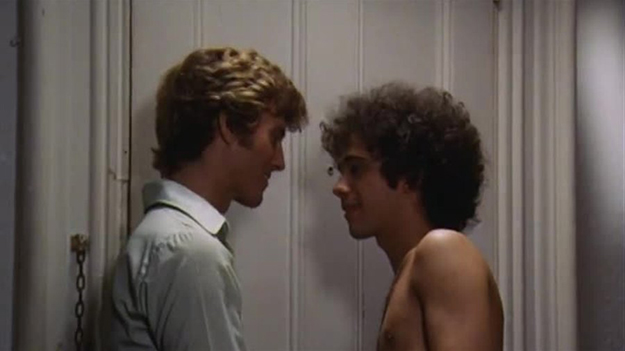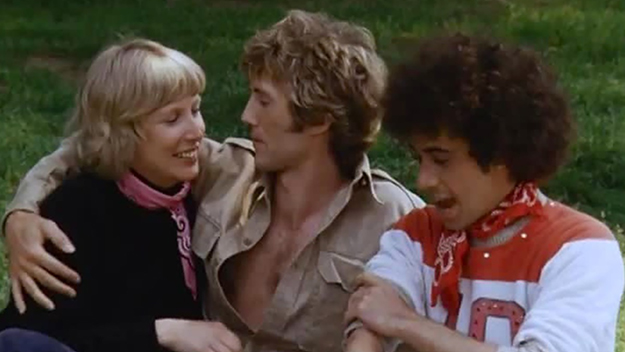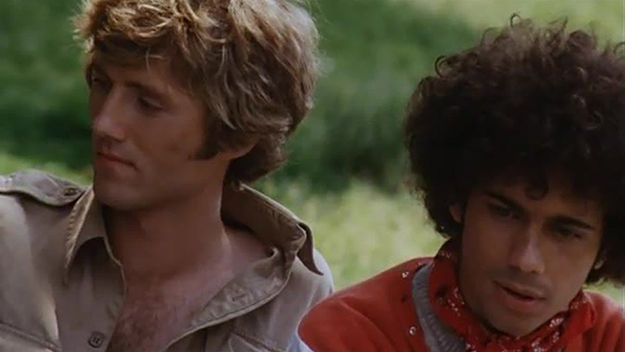Queer & Now & Then: 1975
In this biweekly column, Michael Koresky looks back through a century of cinema for traces of queerness, whether in plain sight or under the surface. Read the introductory essay.

Images from Saturday Night at the Baths (David Buckley, 1975)
It may be not large enough to constitute a subgenre, but gay cinema of the ’70s and early ’80s is its own contained world, as was the post-Stonewall, pre-AIDS period it represents. If one of the great values of film is its capacity to capture a moment in time for posterity, then such fiction films as A Very Natural Thing (1974), with its Fire Island and Provincetown interludes, Nighthawks (1978), an invaluable depiction of the London gay scene, Taxi zum Klo (1981), good-naturedly immersed in West Berlin gay culture, and even William Friedkin’s Cruising (1980), with its unforgettable descent into New York’s leather/S&M bars—modeled on defunct establishments like Ramrod, Anvil, and Mineshaft—are beyond worthy, as documentaries of places and spaces once marginalized, some of them gone. Whereas for the decades during and following the height of the AIDS epidemic, this brief era would be judged by many as representative of “hedonistic” excess, it should be clear to the less narrow-minded viewer that these places embody something more ineffable, that exhilarating feeling of burgeoning freedoms bumping up against lingering repressions. Evidence of these communities remains largely anecdotal and journalistic, and therefore the even rarer filmic proof of their existence is all the more vital.
A prime example of this, Saturday Night at the Baths, directed by first-timer David Buckley in 1975, is part charmingly awkward coming-out narrative, part default full-access documentary. As its title suggests, the star here is the location: The Continental Baths, the once renowned, long shuttered hub of gay New York culture. Located in the basement of the Ansonia, a turn-of-the-century hotel on Broadway between West 73rd and 74th on Manhattan’s Upper West Side, this gay mecca, founded by Steve Ostrow, was equal parts performance space, dance club, hookup spot, and spa, and at the time boasted the world’s largest indoor swimming pool; 400 private rooms were rented out to patrons looking for casual encounters. Predictably, the place was subject to frequent raids by the NYPD, yet it became known—nearly reputable to some—for its music performances, most famously Bette Midler, who made her name as the first Continental Baths superstar, aka Bathhouse Betty (her breakout persona on the bathhouse circuit is referenced in The Rose), as well as Peter Allen, Patti LaBelle, and Barry Manilow, who reportedly accompanied Midler on the piano in just a towel on more than one occasion. In addition to its live performances and lounge acts, The Continental was among the first adopters of the pop genre that would become known as disco, and its industry-legend DJs have been credited with launching countless hit songs, including by the Pointer Sisters and Gladys Knight.
So one could understand why a music job at the Continental would be coveted, which is the premise for Buckley’s film, in which struggling pianist Michael (Robert Aberdeen), a Midwestern transplant in New York, accepts a gig at the Baths, despite the fact that this ostensibly straight-arrow musician is made rather uncomfortable by all the “fags” running the joint. His more free-spirited, open-minded photographer girlfriend Tracy (Ellen Sheppard) is downright tickled by the idea, however, encouraging him to take the job partly in the hopes that it will broaden his social and perhaps sexual horizons. The manner in which Buckley—whose only other directing effort would be the radiantly titled X-rated 1981 comedy Angel Buns—dramatizes this is clunky and perfunctory, though Aberdeen and Sheppard have a casual, jokey intimacy that helps situate the film on an authentic emotional plane. There’s an explicit early sex scene between the lovers that has a lovely grounding effect, establishing their seemingly natural bond and therefore heightening the stakes for the sexual experimentation to come.

As it turns out, Michael’s casual homophobia is a manifestation of internalized loathing, masking his deep discomfort with the self. He ultimately reckons with this thanks to the friendly, and finally erotic, intervention of sweet, wildly frizzy-haired Continental employee Scotti—played by Don Scotti, who was at the time in fact the manager and an occasional MC of the Continental Baths, the casting only enhancing the film’s semi-documentary feel. The banter between Michael and Scotti is often rudimentary, revealing Michael’s cluelessness and casual cruelty, as when Michael nonchalantly calls the out Scotti “not normal” and grows confused when he leaves in a huff: “What’d I say?” Nevertheless, Michael—in no small part due to Tracy’s influence—finds himself increasingly drawn to Scotti, finally confessing to him the homosexual attractions and shames of his youth.
The sexual awakening plot thrust of Saturday Night at the Baths is too heartfelt to be dismissed as filler, but it does often feel like an excuse for the main event, which is a climactic 13-minute sequence that captures a flurry of performances and partying at the Continental. As the title implies, this is just another weekend night out, and Buckley has his characters—fictional Michael and pseudo-real Scotti—slip easily into its rhythms. It’s Michael’s first big accompaniment at the club, and at the last minute he has cruelly, suspiciously disinvited an already dolled-up Tracy. Once at the Baths, the film shifts into a more basic documentary mode, with Scotti bridging the gap, playing his role as face-painted MC. We’re treated to an extended modern-ballet-cum-erotic-wrestling-match by a troupe of men clad only in white briefs; a poignant solo ballad by sweet-voiced Janie Olivor, who was a cabaret circuit fixture and Columbia recording artist of the ’70s; and a succession of usual-suspect drag performances, including Shirley Bassey, Carmen Miranda, a tastefully ass-baring Diana Ross, and Judy Garland, the latter persuasive in her impassioned belting of the Carnegie Hall version of “After You’ve Gone”—which turns out to be a fairly apt choice for a film about a disappearing culture.

There follows a montage of more fleshly delights, including two sudsy studs soaping each other up in the shower, and increasingly frenzied dance-floor hijinks, where Michael flirts with a young woman before turning his attentions to Scotti. Soon, the two find themselves on the quiet city streets, sharing a first kiss while bathed in the shadows of a local church’s stone architecture. Back at Scotti’s apartment, Michael unhesitatingly falls into Scotti’s sloshing waterbed in an earnest, choreographed-to-near-camp sex scene set to a marvelously treacly score of violin, cymbal, and flute; the sensuous camera caresses the curves and wiry hairs of their bodies as their hands explore one another. The sex is eminently polite, a world away from the frenetic movement of the dance floor, yet the message is clear: spending Saturday night at the Baths was the aphrodisiac Michael needed to consummate his hidden homosexual lust.
Despite a surprisingly elegant, emotionally ambiguous final scene, in which Michael admits his transgression to Tracy, one is likely to come away from Buckley’s film thinking more about the authenticity of the milieu it captures than the fates of the various, thinly drawn characters. One cannot talk of the film’s visual texture without referencing the work of German émigré cinematographer Ralf Bode, who was at the start of his career, and who in just the next few years would go on to help create the looks of two quintessential depictions of sexually hyperactive New York: Saturday Night Fever (1977) and Dressed to Kill (1980). In each of these films, the city itself gives off an exciting, dangerous pulse, whether it’s emanating from the blazing colors of a disco club in Brooklyn’s Bay Ridge or the steam-blanketed streets of midtown Manhattan; both incidentally also feature some of the most vivid subway scenes ever shot, getting at the simultaneous confinement and liberation of the urban jungle. Throughout Saturday Night at the Baths, Bode’s camera seems to be in training for those nervy landmark films, capturing the various Manhattan neighborhoods the actors traverse—we get glimpses of the West Village’s 4th Street subway station; Christopher Street, just a block from Stonewall; SoHo galleries; The Bitter End on Bleecker Street—all the while enveloping everyone in a kind of neurotic sexual possibility.
There’s a relief to the realization that so much of what we see on screen still exists in some form—that not everything has been lost to the avalanche of time that makes New York so often feel like a ghost town. This isn’t true of the Continental Baths, which has indeed been long gone, closing officially in 1976, not even a full year after the release of Buckley’s film—suddenly and inadvertently a work of essential documentation. Due to the nature of its way-off-mainstream subject matter and low production values, however, it’s a film that hasn’t been seen by very many in the years and decades since. It only makes sense that a gay-themed film about a mythic homosexual Shangri-La would be itself lost to time. Queer histories have historically been buried while time marches on. By 1977, the Ansonia Hotel basement would be transformed once again, this time into the location for Plato’s Retreat, the infamous heterosexual swingers’ club. That’s got to be considered some form of erasure.
Michael Koresky is a writer, editor, and filmmaker in Brooklyn. He is cofounder and editor of the online film magazine Reverse Shot, a publication of Museum of the Moving Image; a regular contributor to the Criterion Collection and Film Comment, where he writes the biweekly column Queer and Now and Then; and the author of Terence Davies, published by University of Illinois Press, 2014.







